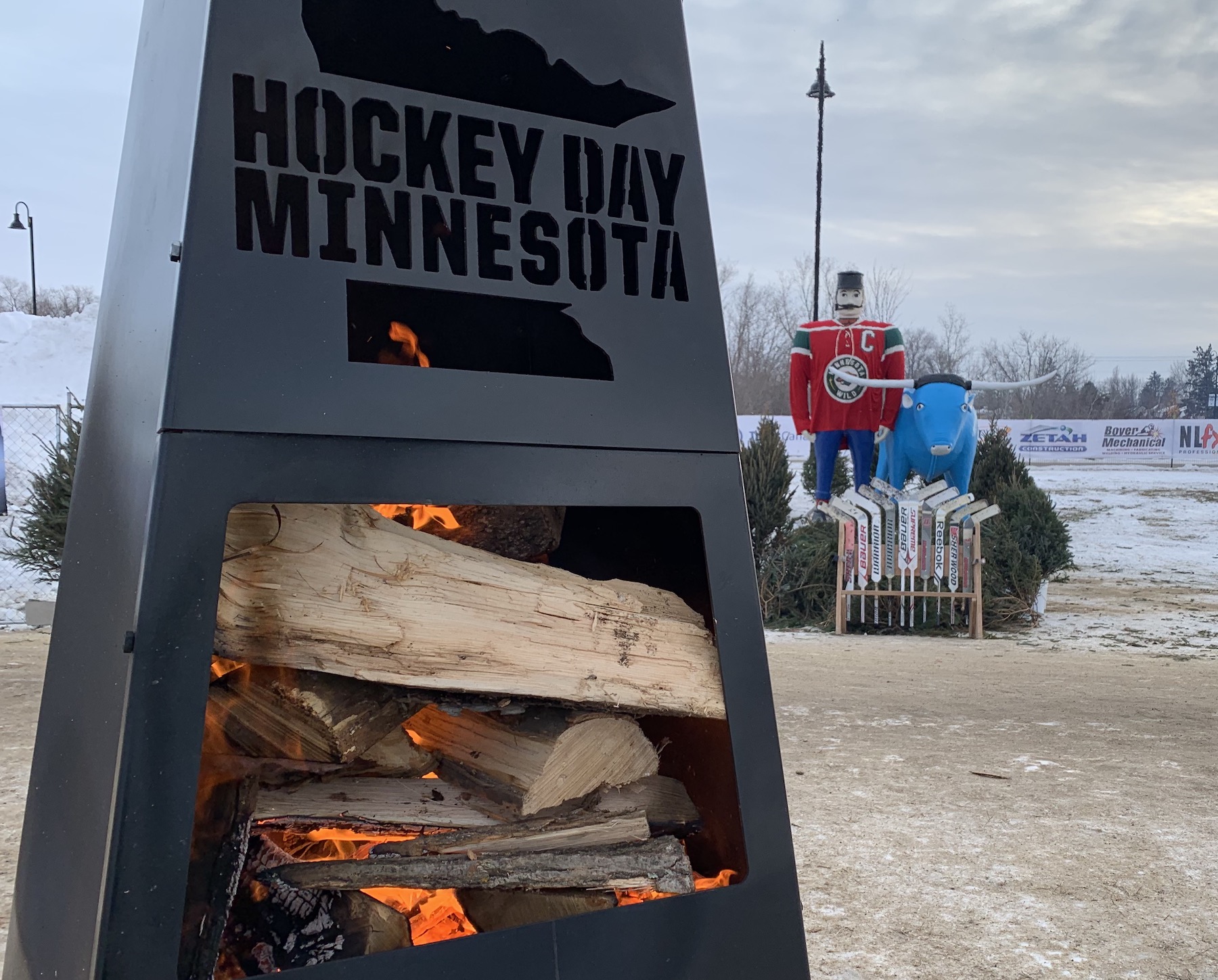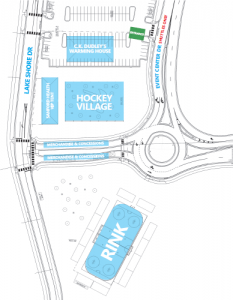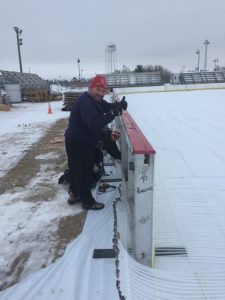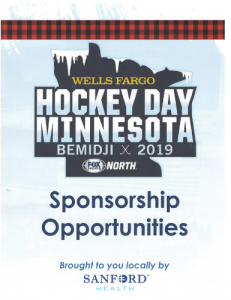
30 Mar
HDM2019 Interview – How It Works
Today we will continue our conversation with the organizers of Hockey Day Minnesota 2019, hosted in Bemidji on January 17-19. Actually, as you’ll see, it’s a lot more than just three days of hockey!
We’re appreciative of members of the Local Organizing Committee and Minnesota Wild for taking the time to sit down with us a short while after the event and give us their perspective on how a large event like this worked.
If you want to read more on how this event came to be, check out our Overview post, our Making It Happen! interview, or our The Payoff interview.
Let’s continue hearing from some of the key people. My questions and comments will be in bold, with the responses in black.
TK – Tom Kuesel, Local Organizing Committee Chair
KW – Kevin Waldhausen, Local Organizing Committee
KC – Kris Christopher, Local Organizing Committee
TP – Tracy Pogue, Local Organizing Committee
JM – John Martens, Local Organizing Committee
WP – Wayne Petersen, Minnesota Wild
This is a Minnesota Wild event. How does that partnership with your local organization work?
TK – The event is owned by the Minnesota Wild, Fox Sports North is the broadcast partner. Our contract is with the Wild. It’s kind of a three headed monster. All three of us have to work in concert or it doesn’t happen.
TP – They need us to pull it off, we need them for the game. All of the high school games and the college game and it’s got to be broadcast somehow. Hockey Day doesn’t exist without the three-legged stool there.
TK – It’s about a 13 page contract.
How far ahead did sponsorships and media have to be in place before the event actually came?
TP – From day one we wouldn’t sign the contract with the Wild until we had an agreement with Sanford Health (main local sponsor). There’s a little bit of a leap of faith, but there are legal exposures we have to cover as well. Lead time was a year at least.
Did you call yourselves the Hockey Day Committee, or did you ever have a name?
TP – We called ourselves the Executive Committee.
KC – Or the LOC, Local Organizing Committee.
How did you structure and fund your organization for the event?
TK – One of the fun things about this event is we had been given the blueprint or notes from other communities that have done it. Now it’s grown much bigger, but we started with that and said, we need a hospitality committee, we need a volunteer committee, a finance and sponsorship committee, and then assigned heads for each of those committees and grew members underneath them. For example, under the arena committee I had 10 other guys that were helping me put that rink together.
In terms of funding it, before we made our bid to the Wild we did some informal behind the scenes fundraising to say, “Hey, if we get this event, will you pledge X amount because we need that seed money, if we don’t have that seed money we probably can’t afford to do this.” And it didn’t take us more than 2 months to be confident that we had enough seed money to make the bid.
TP – That was kind of the nervous point of it, because the day you say yes, you start spending money. So we actually had about 8 or 9 major sponsors, not knowing the date, not knowing the teams, not knowing anything other than they trusted us and they knew that this was a big event, to come onboard and in some cases writing us a check within weeks of our ask. Our bank account was waiting for that money. So we had money in the bank before we started needing it, because you can’t go in debt!
TK – No Hockey Day has lost money yet, and we don’t want to be the first.
What were the key partnerships needed to make this event work, and why?
TP – First and foremost, Sanford Health. (Murmurs of agreement) We could not have done this without Bryan Nermoe at Sanford Health committing to us up front, “I’m in, all in,” and when asked, they upped their ante, way, way early, like two years in advance. And when we got to the event, they surprised us by leaps and bounds. The VIP tent was extraordinary… First and foremost to me was Sanford Health.
TK – The City needed to be a big partner. It was their property, and a lot of that stuff that we did we needed their approval, like the liquor license and site acquisition.

KW – The site that we did it on was actually for sale. We needed to secure that site and make sure that between our proposal and the event, it didn’t get sold.
TP – And as fate would have it, I’ve been told that it did get sold, there’s a purchase agreement on it, contingent that after Hockey Day it’s still in the same condition. I don’t know if that’s true or not. The village portion.
TK – Street closure, barricades, traffic, the City was involved. BSU was another big partner, not necessarily financially, but agreeing to have their teams play outdoors, which is a big commitment. Getting their league behind it, which is a big thing.
TP – I think Kris’s committee and volunteers as a community, the commitment our community did, I can’t even imagine how many hours were put in. How many volunteers did we have?
KC – Online we had 485 shifts, and that didn’t include any supervisors and some shifts were off the grid. So at least 500 people. An average of 3 hours. Some were 2, any indoor shift was 4 hours.
TP – You pull that together and it’s as important as KA’s or Sanford or anybody’s commitment. You can’t do that without the people.

KC – There are so many moving parts. Without this, you can’t facilitate everything that needs to be done. Without the financial support, you can’t move forward with the plans that you want to make. A lot of crossover in everything, every area is dependent on the other to be successful.
We asked Wayne Petersen, Director of Community Relations for the Minnesota Wild for his perspective on creating the partnerships for a successful event as well.
WP – Our goal now, and we’re on track every year, when we were in St. Cloud 2018 is when we announced we would be in Bemidji 2019. When we were in Bemidji 2019, we announced that we would be in Minneapolis for HDM2020. We want to be a year out every year to announce who will be hosting the next Hockey Day. Obviously there is a lot of (activity) before we get to that point. Myself and a couple individuals from Fox Sports North will do multiple site visits to ensure the sites will work from a logistical standpoint. We’ll have some meetings about all sorts of things relating to the weekend.
Obviously we have to have a signed contract before we announce who the host community will be. I’m already in conversations with communities regarding HDM2021. Right now we’re in March 2019. We work that far out in advance. It’s so beneficial for LOC’s to go see a Hockey Day first hand, like Tom Kuesel and others did. They went to Stillwater and St. Cloud. The Minneapolis committee was in St. Cloud and Bemidji. What else is nice is that all of the chairs of the past Hockey Day Committees have been so willing to pay it forward. They’re open to answering any questions they have and share any information that they need to help future communities host successful events.
Once we announce where we’re going, obviously the lions share of the work is done in the local community. We have periodic conference calls and periodic meetings that happen with more frequency as we get closer and closer to the date. But the lions share of the work is done by the Local Organizing Committee and all the volunteers. They deserve by far the most credit for hosting this event.
Back to our LOC:
What did the local timeline for planning and implementation look like? What needed to happen and when in order to be successful?
KC – We first started out, we started early just to try to educate people about what the event was going to be like, more than just hockey games. Trying to share with them that we needed community support and a means of sponsorship and generating volunteer support and all of that. From the go, when we were awarded it, for a long time until late fall there was an education process trying to secure all that we could.
Oddly enough, as much you start that early on, people aren’t necessarily tuned in. Some people heard it, some understood. There were potential sponsors that came to us in December that wanted to be a part of that. We were beyond the deadline to give you what we proposed.
For volunteers it was great, yes, we had a spot to fill. But even at that, I know that some of the people that wanted to commit to helping, I had been talking to them for months or sharing information, but it’s off their radar because to them, you can try to plan in advance, but some people are working day to day or week to week they’re not looking so far in advance. I still think you need to do that, it’s important to start sharing early on to generate that support that you need.
KW – We were hosting an event in frozen January. Well, you can’t do things on the site in frozen January, so the logistics of getting the site ready have to be done before freeze up. So we were coordinating Otter Tail Power and Paul Bunyan Communications and NLFX and getting the site ready, the chiller trenches have to be done and the base of the rink has to be all set up before ground freeze, and then we have to protect all this during the snow. A lot of areas were covered with massive tarps so that when the event came we could pull the tarps so that there was dry asphalt underneath there. That was a coordinated effort with our partners.

This was all done on volunteer time, they’re still trying to run their businesses but still get down to do their commitment to us that went above and beyond. Most people didn’t see what was going on at that time, it was magical. Wednesday afternoon when Business X was trying to make a living, they were down there on site getting ready for an event that’s going to be happening 3-4 months down the road.
We also heard from John Martens, who organized the social media and promotional efforts for the Local Organizing Committee. John gave us some great insights into how the focused and effective marketing campaign worked.
JM – One of our first marketing objectives for Hockey Day Bemidji was developing a social media and online marketing strategy to provide Hockey Day news, updates, events and create engaging content to build excitement leading up to and during the event. Developing social media and online presence for Hockey Day Bemidji was a challenge on a few fronts.
First, the MN Wild and Fox Sports North own the rights to all things Hockey Day, respectively, including websites and social media. Therefore, we didn’t have the opportunity to create an official local Hockey Day Bemidji website and social media accounts. Instead, we used the local social media platforms we had available with @BemidjiHockey as our “official unofficial” Hockey Day account and it worked well.
Second, we wanted to incorporate our sponsors and feature their brands with Hockey Day rather than creating a simple “thank you” post whenever possible. We took behind the scenes teaser photos, team photos, and applicable product features whenever possible. Our sponsors were simply amazing and we wanted to highlight them whenever possible.
Sponsorships and funding are a big part of a community event like this. How did you organize and structure your fundraising efforts, and how well did it work?
TP – [Handed me a sponsorship brochure] I didn’t go anywhere without one of these for the last two years.

KC – That was great, just having printed material that outlined the specifics, and it’s a consistent message that we could refer to, that was a great piece.
TP – When we first decided we were going to split off and have different committees and I was going to spearhead the sponsorship (drive), within our own room we had relationships (with potential sponsors), and then we formed a sponsorship committee. I think we had 23 people on that committee.
Rather than just going through the phone book and making asks, it was all relationship based – who knows x over at y, that kind of thing. We had some very specific asks, because we knew we were going to need something from that company, whether it was Otter Tail in power, Kraus Anderson in construction trailers, whatever that ask was, we kind of targeted that. Cash wasn’t always king, we needed stuff and lots of it.
From the Minnesota Wild’s perspective, what did Bemidji do right that helped you make this a successful event?
WP – What’s cool is that each community has put their own local spin to it or local flavor to it or local look. What they did with that big jersey on Paul Bunyan, it just had a cool local flavor to it. Obviously, it was a successful event in the fact they sold so many tickets and sold so many sponsorships. But there was also the Hockey Day village, and there was a lot of plaid, which was awesome! It stood out from all the others.
For example, Bemidji State played Minnesota State Mankato in the women’s game, and the MS coaching staff wore purple and black plaid bomber hats and jackets, because they were playing in Bemidji! If they were playing in St. Cloud or Stillwater, they wouldn’t have worn the hats. It really had a cool Bemidji flavor to it. I think that’s what made it special. The fact that it was right on the shores of Lake Bemidji, made it really special.
If you like this, please follow our social media links or enter your email in the box to the right in order to receive notification of our next post. Next time, we’ll continue the conversation around what hosting an event like this achieved for the community – how it built the woodpile higher! Please leave us your thoughts or questions in the comments below!
Kevin Waldhausen
Great read, can’t wait for the next segment.